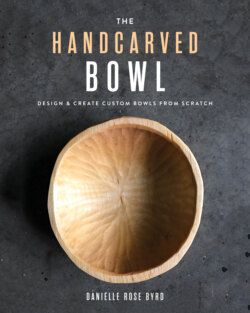Читать книгу The Handcarved Bowl - Danielle Rose Byrd - Страница 10
На сайте Литреса книга снята с продажи.
Оглавление10
T H E H A N D C A R V E D B O W L
INTRODUCTION
W
oodworking appeals to so many people because it
gives us the opportunity to work with our hands to
make something tangible, and maybe even useful, too.
Or perhaps it’s to feel a connection to something after
working a job that isn’t all that fulfilling, or to help
ease anxiety, or get outside. Bending, shaping, carving,
and cutting are more than just steps to create an ob-
ject, but I suspect most of you know this already. Sure,
this book is a guide to bowl carving, but I hope that it
also serves as a reminder to enjoy the process, even
when we feel like we’re failing, and especially when we
feel like we’re failing.
Working green wood is an inherently risky process,
and the number of things that could go wrong is,
frankly, overwhelming. The material itself demands
a good deal of consideration and respect, and
sometimes even when we grant it every forethought
we can muster, it will still find a way to humble
our incessant desire for certainty. And I find this
absolutely exhilarating! Many of my best designs have
been born from what I originally deemed failures,
so I’ve learned to treat my response to them as yet
another skill to hone.
The beauty of this process is that it also presents us
with the opportunity to make mistakes deliberately,
ones we can feel with our hands, and see with our eyes,
and better learn how to remedy. With so many other
abstract and complex problems in our world, witness-
ing the unfolding right in our hands, and because
of our hands, gives us the ability to see exactly what
needs to be done to fix it. Our drive to become better
with our tools, I would argue, is not to make a prettier
bowl or a smoother surface, but to chase the certainty
we seek in other arenas—the things we couldn’t possi-
bly fix in one carving session.
In recent years, green woodworking has taken off,
and it’s no surprise why—it requires little overhead
in the way of tools, space, and materials, at least
compared to machine woodworking, and projects
can usually be completed in a fraction of the time it
would take to fully realize a piece of fine furniture. The
high moisture content of green wood makes it easily
workable compared to dried wood, and a downright
pleasure to work with hand tools. At one point or
another, a good deal of us have had the experience
of using a simple pocketknife to make a mere stick
into a deadly spear. And what a spear it was! It’s likely
most of us were having our first encounter with green
woodworking without even knowing it.
My own journey into this field began in western
Maine, where shop class was still a thing back in the
90s. Though few have survived since, trade programs
like this were originally influenced by the Russian
system, and brought into American schools at the
turn of the 20th century to quickly equip students for
industrial jobs. This way of teaching focused more on
production, and not the development of the student in
both mind and body.
The sloyd system was brought over to the U.S. from
Sweden at around the same time, and caught on
in pockets, specifically at the North Bennet Street
School in Boston. The sloyd focus was on the student
as a whole—mental, physical, and moral—while also
creating things of use. It introduced young children
to hand skills with sharp tools starting at a young
age, which was looked down upon. Meanwhile, the
American Dream took hold, along with the teaching
methods that churned out workers to produce goods
and feed the dream, and the sloyd system fell to
the wayside.
